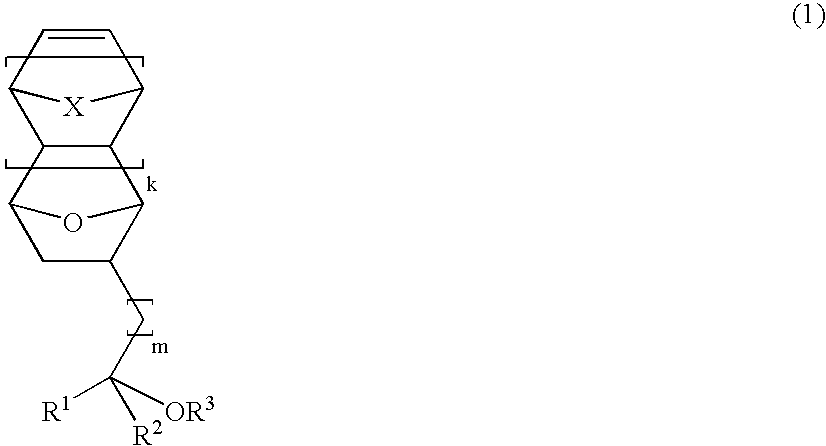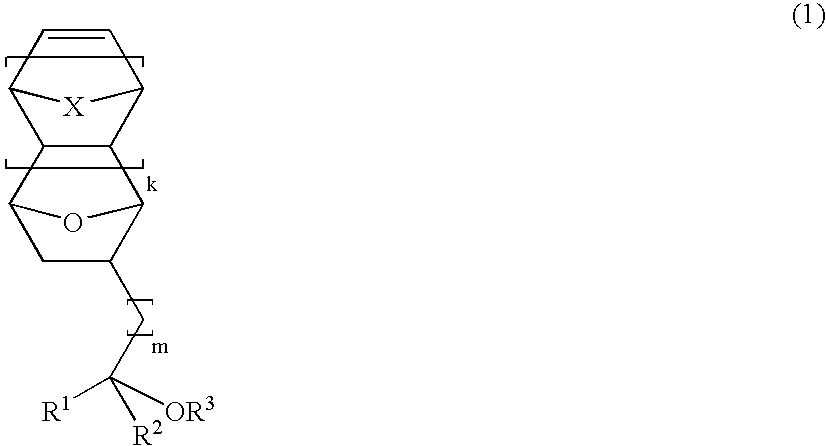Novel epoxy compounds having an alicyclic structure, polymer compounds, resist materials, and patterning methods
a technology of epoxy compounds and resist materials, applied in the direction of photosensitive materials, auxillary/base layers of photosensitive materials, instruments, etc., can solve the problems of difficult to heighten the rigidity of resist materials, none of them satisfactory, and the practically usable level of resist materials are not yet available, etc., to achieve excellent adhesion with a substrate, small absorption, and high energy beams
- Summary
- Abstract
- Description
- Claims
- Application Information
AI Technical Summary
Benefits of technology
Problems solved by technology
Method used
Image
Examples
synthesis examples
[0160] The epoxy compound of the present invention was synthesized in accordance with the following formulation.
synthesis example 1-1
[Synthesis Example 1-1]
Synthesis of 5-methoxymethyl-7-oxa-2-norbornene (Structural Formula 13)
[0161] To a mixture of 3.8 g of lithium aluminum hydride and 100 ml of dry tetrahydrofuran was added 15.4 g of methyl 7-oxa-5-norbornen-2-carboxylate over 1 hour at 30° C. under a nitrogen atmosphere. After stirring for 3 hours, 3.8 g of water was added to terminate the reaction. To the reaction mixture were added 3.8 g of a 15% aqueous sodium hydroxide solution and 11.4 g of water. The resulting mixture was filtered, followed by concentration. The residue was purified by distillation under reduced pressure, whereby 11.9 g of 5-hydroxymethyl-7-oxa-2-norbornene was obtained (boiling point: 86 to 88° C. / 80 Pa, yield: 95%). The product thus obtained was added to a mixture of 2.6 g of sodium hydride and 100 ml of dry tetrahydrofuran at 20° C. under a nitrogen atmosphere. After stirring for 1 hour, the mixture was heated to 40° C. and 19.9 g of methyl iodide was added. The resulting mixture was...
synthesis example 1-2
[Synthesis Example 1-2]
Synthesis of 5-acetoxymethyl-7-oxa-2-norbornene (Structural Formula (15))
[0164] To a mixture of 33.8 g of 5-hydroxymethyl-7-oxa-2-norbornene, 31.8 g of pyridine and 0.1 g of 4-dimethylaminopyridine, 35.6 g of acetic anhydride was added over 1 hour at 25° C. After stirring for 8 hours, 50 g of water was added to terminate the reaction. The reaction mixture was then extracted with ethyl acetate. The organic phase was washed with brine, dried over anhydrous sodium sulfate and concentrated under reduced pressure. The residue was then purified by distillation under reduced pressure, whereby 41.9 g of 5-acetoxymethyl-7-oxa-2-norbornene was obtained (boiling point: 73 to 74° C. / 35 Pa, yield: 93%).
[0165] IR (thin film): ν=3077, 3002, 2950, 2894, 2873, 1739, 1386, 1367, 1317, 1236, 1155, 1095, 1037, 1002, 975, 919, 852, 771, 711 cm−1
[0166]1H-NMR (300 MHz in CDCl3) of the main isomer: δ=0.75(1H, dd), 1.99-2.07(4H, m), 2.45-2.56(1H, m), 3.58(1H, t), 3.99(1H, dd), 4.95...
PUM
| Property | Measurement | Unit |
|---|---|---|
| temperature | aaaaa | aaaaa |
| temperature | aaaaa | aaaaa |
| temperature | aaaaa | aaaaa |
Abstract
Description
Claims
Application Information
 Login to View More
Login to View More - R&D
- Intellectual Property
- Life Sciences
- Materials
- Tech Scout
- Unparalleled Data Quality
- Higher Quality Content
- 60% Fewer Hallucinations
Browse by: Latest US Patents, China's latest patents, Technical Efficacy Thesaurus, Application Domain, Technology Topic, Popular Technical Reports.
© 2025 PatSnap. All rights reserved.Legal|Privacy policy|Modern Slavery Act Transparency Statement|Sitemap|About US| Contact US: help@patsnap.com



